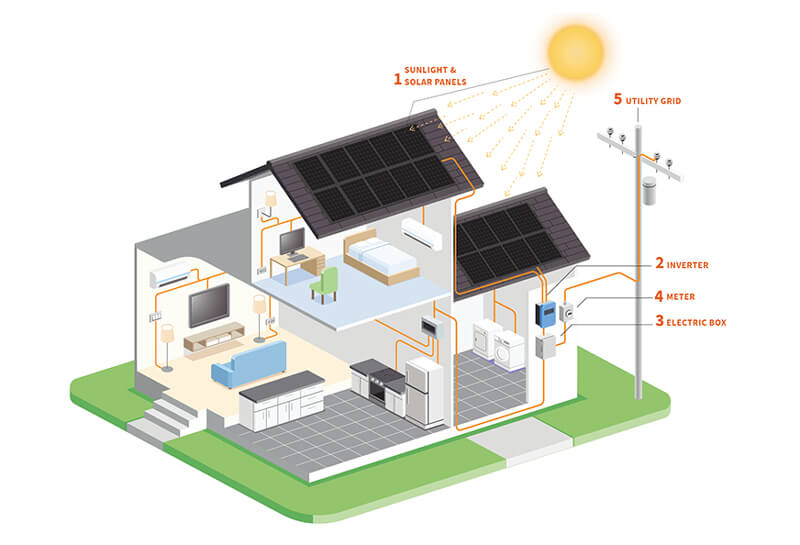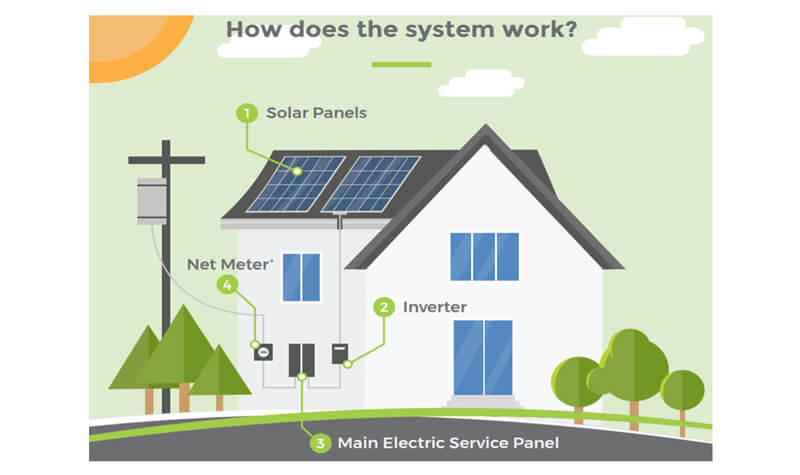Contents:
Solar panels are an excellent investment for anyone looking to reduce their energy bills and carbon footprint. However, ensuring that your solar system is functioning correctly can be a concern, especially if you're new to solar energy. Here’s a detailed guide to help you determine whether your solar panels are working effectively.

1. Check the Solar Inverter
The solar inverter is the heart of your solar panel system, converting the direct current (DC) produced by your panels into alternating current (AC) that can be used by your household appliances. If your inverter isn't working properly, your panels won’t be delivering electricity effectively.
Most inverters come with a display panel, typically featuring indicator lights to signal the system's operational status. Here’s a common color code:
-
Green light: Everything is functioning correctly, and your system is producing power.
-
Red or orange light: This may indicate a fault, and the system might not be generating energy.
Additionally, the inverter display should show readings of energy production, typically in kilowatt-hours (kWh). Monitoring this regularly can give you insight into whether your system is performing as expected.
2. Use a Solar Monitoring System
A solar monitoring system provides a real-time, comprehensive view of your solar energy production. Most modern solar systems come with a monitoring feature, either integrated into the inverter or available as a separate device or app. Monitoring platforms offer insights into various aspects, including daily production, historical data, and efficiency trends. They can also notify you if something goes wrong, allowing you to address issues promptly.
To help illustrate, here is a sample table showing what a monitoring system display might look like. Each entry represents data collected over a week, with production values recorded daily.
|
Day
|
Production (kWh)
|
Status
|
|
Monday
|
12.4
|
Normal
|
|
Tuesday
|
13.1
|
Normal
|
|
Wednesday
|
10.8
|
Cloudy
|
|
Thursday
|
12.0
|
Normal
|
|
Friday
|
11.9
|
Normal
|
|
Saturday
|
9.5
|
Rain
|
|
Sunday
|
12.3
|
Normal
|
3. Monitor Your Utility Bill
If your solar panels are producing the expected amount of energy, your monthly utility bill should reflect lower energy usage from the grid. Compare your bills before and after installation. A consistent reduction in electricity charges signifies that your panels are working.
If you notice minimal or no change, it may be worth checking for issues or contacting your solar provider.
4. Observe Changes in System Efficiency Over Time
Solar panel efficiency naturally decreases by about 0.5% each year. However, if you notice a significant drop in production within a short period, it may be an indication that your panels are not functioning correctly. Consistent monitoring can help you identify such trends and address issues promptly.
5. Inspect for Physical Damage
Perform a visual inspection of your solar panels regularly. Look for cracks, debris, or any noticeable wear that might impede sunlight absorption. Clear any dust or leaves that may accumulate, as they can block sunlight and reduce efficiency.
6. Track Weather Patterns and Seasonal Changes
Weather conditions and seasonal shifts naturally affect solar panel performance. On cloudy or rainy days, you can expect a drop in production. Seasonal changes also influence sunlight intensity and duration. For instance, in winter, shorter days and a lower sun angle might reduce energy generation. By understanding these variations, you can better interpret your system’s production and distinguish between normal seasonal dips and potential issues with the system.
7. Use a Multimeter to Test Individual Panels
If you suspect a specific panel isn’t working, you can use a multimeter to measure its output. This device allows you to test the voltage and current directly from the panel. First, set the multimeter to measure DC voltage, then connect it to the panel’s terminals. Compare the reading to the panel's rated voltage (typically found on the back of the panel). If there’s a significant discrepancy, the panel might have an issue and may need maintenance or replacement.
8. Contact Your Solar Provider for a Professional Check-Up
If you've noticed unusual drops in production or errors on your inverter, consider reaching out to your solar provider. Many providers offer maintenance and performance check-ups. A professional can diagnose more complex issues like inverter malfunctions, wiring problems, or degradation in the panels themselves. Scheduled maintenance checks ensure your system operates at peak efficiency and catches potential issues early.
9. Ensure Proper System Ventilation
Solar panels can lose efficiency if they overheat. Although they're built to withstand high temperatures, excessive heat can cause a reduction in performance. Make sure there's adequate airflow beneath your panels. Most installations include a gap between the roof and the panels to allow ventilation. If your setup lacks this, consult with an installer to see if improvements can be made.
10. Examine the Mounting Structure and Orientation
Solar panels must be correctly angled and oriented to capture maximum sunlight. If panels have shifted due to wind or other environmental factors, this can impact their effectiveness. Regularly inspect the mounting structure to ensure stability and the correct angle. If you find any misalignment, consider adjusting the panels or consulting your installer to maintain optimal positioning.
11. Check for Shade Throughout the Year
Solar panels perform best with consistent, direct sunlight. As trees grow or nearby buildings are constructed, shading patterns around your home may change over time. Shade, even on a small part of one panel, can impact the entire system if the panels are connected in series. Periodically assess your system’s exposure to sunlight, especially in different seasons, and consider trimming trees or adjusting the panels if necessary to reduce shade.

12. Review the Energy Production During Peak Sun Hours
Peak sun hours refer to the time during the day when the sun is strongest, usually between 10 a.m. and 4 p.m. Monitoring your energy production during these hours can give you a clear indication of your panels' performance. Consistent low production during these hours might suggest a need for further inspection. You can use this metric to establish a performance baseline, helping you track efficiency over time.
13. Clean Your Solar Panels Regularly
This chart shows how regular cleaning maintains solar panel efficiency over time.
Dirt, bird droppings, pollen, and other debris can accumulate on the surface of solar panels, reducing their efficiency by blocking sunlight. Cleaning your panels every few months, or more often if you live in a dusty or high-pollen area, can significantly improve their performance. Use water and a soft brush, or consider hiring a professional cleaning service to avoid damage.
14. Understand Your System’s Warranty and Performance Guarantee
Many solar panels come with a warranty or performance guarantee, typically lasting between 20 to 25 years. These warranties often include a guaranteed level of efficiency, which can help you understand what to expect from your system over time. Reviewing the warranty terms can also clarify your options if you encounter performance issues or unexpected degradation.
15. Compare Your Energy Production with Local Averages
Solar energy production can vary depending on location and climate. Comparing your system’s output with local averages or data from similar systems in your area can provide context for your panel’s performance. Many utility companies or online resources provide average solar production data for different regions, which you can use as a benchmark.
By keeping a close eye on these indicators, you can ensure your solar panels are operating at their highest potential, maximizing the benefits of your investment in clean energy. Regular monitoring, maintenance, and a proactive approach to managing your system will help you enjoy reliable solar power for years to come.
FAQs







